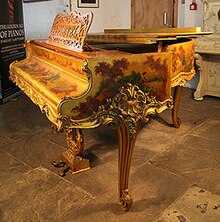Vernis Martin
In French interior design , Vernis Martin is a type (or series of types) of Japanning - or imitation lacquers , named after the 18th century French Martin brothers : Guillaume (died 1749), Etienne-Simon , Robert and Julien . They ran a leading factory between around 1730 and 1770 and were vernisseurs du roi (“King's painters”).
But they neither invented the process, nor were they the only manufacturers, nor does the term encompass a single formula or technique. It mimicked Chinese lacquer and European motifs and was applied to a wide variety of items from furniture to carriages. It is said to have been made by heating oil and copal and then adding Venetian turpentine .
history
Oriental lacquer had quickly gained great popularity in France and many attempts were made to imitate it. Some of these attempts have been passably successful, and it is likely that many of the examples given by Louis XIV . Owned at his death, were of European manufacture. However, Chinese varnish was imported in large quantities, and panels were sometimes made in China from patterns made in Paris.
Biographical details of the Martin brothers' career are sparse, but it is known that Guillaume, the eldest, was in the business as early as 1724. Their method and work must have quickly become fashionable, because in 1730 Guillaume and Simon Martin were granted a twenty-year monopoly by patent, which is later renewed to create “toutes sortes d'ouvrages en relief de la Chine und du Japon” (“all kinds of aid organizations from China and Japan ”). At the height of their fame, the brothers ran at least three factories in Paris, and in 1748 they were all classified as a "Manufacture nationale". One of them still existed in 1785.
The literature of their time had a lot to say about the Martin brothers. In Voltaire's comedy Nadine from 1749 a berline (carriage) “bonne et brillante, tous les panneaux by Martin sont vernis” (“good and bright, all panels painted by Martin”) is mentioned. The Marquis de Mirabeau in L'Ami des hommes refers to the enameled snuffboxes and lacquered carts that came from the Martins' factory. As with many great artists, their names were tied to many works they had never seen, and the Martins suffered greatly in that regard. The fact that the quality of their production fluctuated between very wide limits is proven by existing and undoubtedly examples; but it is extremely unlikely that even their three factories could have produced the amount of examples ascribed to them. However, their production was large and varied, for the greed for their varnish was so great that it was applied to every possible object.
The fashion was not limited to France. At best, Vernis Martin has a gloss, polish and translucency that compel admiration. Every kind of Asian lacquer from the Far East was imitated and often improved by the Martins - the black with raised gold ornaments, the red and finally in the green background, powdered with gold, they reached the zenith of their art. This delicate work, poudré and curled with gold or half flowers covered with transparent enamel, is best shown on small boxes, fans, needle cases and the like. Many of the larger specimens from the Martins factories have disappeared or been cut into decorative panels. It seems that none of the works they placed in the famous hotels of old Paris are now on site, and the really fine examples are in museums. Even the decorations of the Dauphin's apartments in the Palace of Versailles , which were made or at least begun in 1749, have disappeared; also have the ones at the Château de Bellevue.
Critics have accepted that of the four brothers, Robert Martin did the most original and complete artistic work. He left a son, Jean Alexandre, who in 1767 referred to himself as Vernisseur du Roi de Prusse ("painter of the King of Prussia"). He was employed in the palace of Sanssouci but could not continue the great traditions of his father and uncles. The French Revolution eventually wiped out a taste that had lasted much of the 18th century.
bibliography
- Frederic Jones: The Concise Dictionary of Interior Design. Crisp Publ., Los Altos, Calif. 1990, ISBN 1-56052-067-1 .
- Harold Osborne (Ed.): The Oxford Companion to the Decorative Arts. OUP, 1975, ISBN 0-19-866113-4 .
- Marianne Webb: Lacquer: Technology and Conservation: Technology and Conservation. Butterworth-Heinemann, Oxford 2000, ISBN 0-7506-4412-5 .
- David Garrioch: The Making of Revolutionary Paris. University of California Press, Berkeley 2002, ISBN 0-520-24327-7 .
Web links
Individual evidence
- ↑ Penderel Brodhurst, James George Joseph: Vernis Martin . In: Chisholm, Hugh (Ed.): Encyclopedia Britannica . 11th edition. tape 27 . Cambridge University Press, 1911, pp. 1032 .

